AU修饰的TIO2
二氧化钛
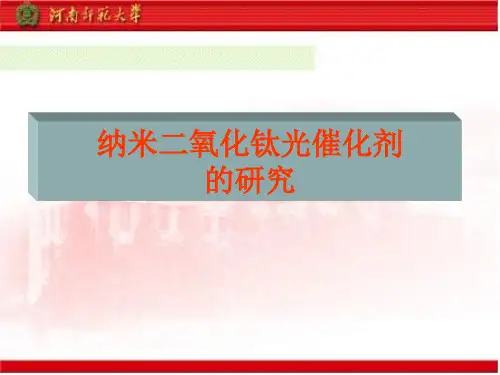
纳米二氧化钛利用自然光在常温和常压条件下即可催化 分解细菌和污染物,无毒,环境友好。
➢ 纳米TiO2的光催化原理
关于TiO2光催化机理,目前较为成熟的是基于半导体 能带理论的电子—空穴作用机理。作为一种n 型半导体材 料,TiO2的能带是由一个充满电子的低能价带和一个空的 高能导带构成,价带和导带之间的区域为禁带,禁带的宽 度为带隙能(禁带宽度)。 TiO2的带隙能为3.0~3.2eV ,相当 于波长为387.5nm的光子能量。
其主要反应如下所示: TiO2 + hν→e- + h+ , h+ + OH- →·OH , h+ + H2O →·OH + h+ , e- + O2 →·O2- , ·O2- + h+ →HO2·, 2HO2·→O2 + H2O2 , H2O2+·O2- →·OH + OH- + O2
TiO2受紫外线激发而产生的h+是一种强氧化剂,可直接氧 化许多有机物。同时·O2-和·OH也具有很强的化学活性。·O2能和多数有机物反应,将其氧化分解为CO2和H2O 。
由于TiO2量子效率低,难以用来处理数量大、浓度高 的废水,为了提高TiO2光催化活性和对光的利用率,缩短 催化剂的禁带宽度使吸收光谱向可见光扩展,是提高太阳 能利用率的技术关键.改性后的TiO2降低了电子一空穴在 表面的复合机率,将可利用光谱从紫外光区扩展到可见光 区,体现出了越来越多的优越性.
在可见光下,这类光敏化物质有较大的激发因子, 使光催化反应延伸到可见光区,扩大了激发的波长的最 高占有能级、半导体的能级以及最低空能级的支配。当 色素的最低空能级的电位比半导体的导带能级的电位更 负时,产生电子输入的光敏化,而半导体的能隙高于色 素,在这种情况下,半导体不能被激发但是色素可以被 激发。
二氧化钛的三种晶型
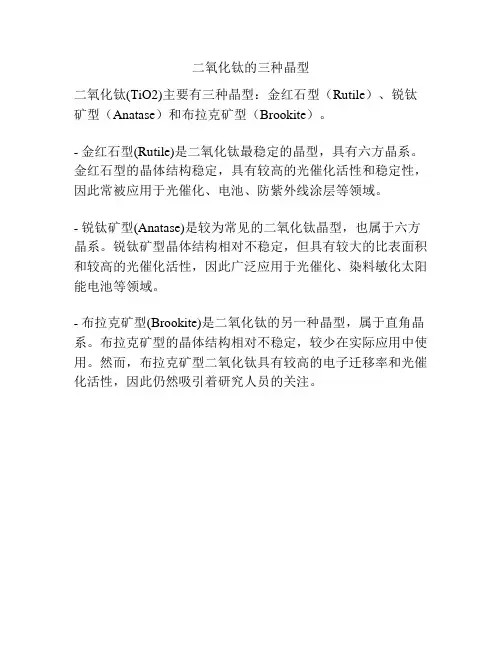
二氧化钛的三种晶型
二氧化钛(TiO2)主要有三种晶型:金红石型(Rutile)、锐钛矿型(Anatase)和布拉克矿型(Brookite)。
- 金红石型(Rutile)是二氧化钛最稳定的晶型,具有六方晶系。
金红石型的晶体结构稳定,具有较高的光催化活性和稳定性,因此常被应用于光催化、电池、防紫外线涂层等领域。
- 锐钛矿型(Anatase)是较为常见的二氧化钛晶型,也属于六方晶系。
锐钛矿型晶体结构相对不稳定,但具有较大的比表面积和较高的光催化活性,因此广泛应用于光催化、染料敏化太阳能电池等领域。
- 布拉克矿型(Brookite)是二氧化钛的另一种晶型,属于直角晶系。
布拉克矿型的晶体结构相对不稳定,较少在实际应用中使用。
然而,布拉克矿型二氧化钛具有较高的电子迁移率和光催化活性,因此仍然吸引着研究人员的关注。
TiO2的介绍
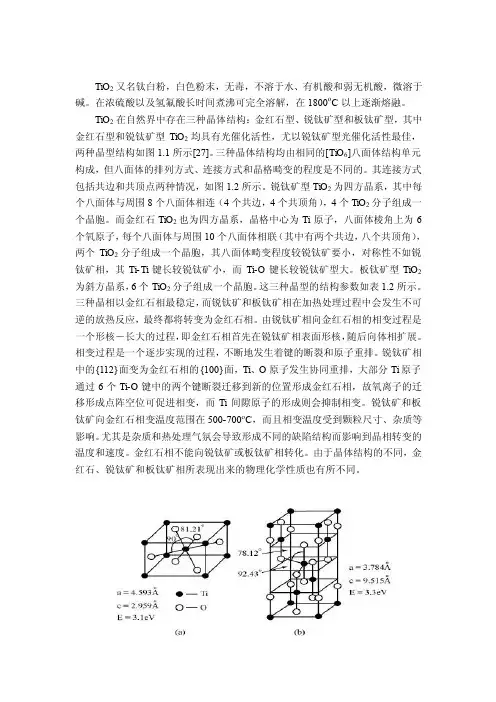
TiO2又名钛白粉,白色粉末,无毒,不溶于水、有机酸和弱无机酸,微溶于碱。
在浓硫酸以及氢氟酸长时间煮沸可完全溶解,在1800o C以上逐渐熔融。
TiO2在自然界中存在三种晶体结构:金红石型、锐钛矿型和板钛矿型,其中金红石型和锐钛矿型TiO2均具有光催化活性,尤以锐钛矿型光催化活性最佳,两种晶型结构如图1.1所示[27]。
三种晶体结构均由相同的[TiO6]八面体结构单元构成,但八面体的排列方式、连接方式和晶格畸变的程度是不同的。
其连接方式包括共边和共顶点两种情况,如图1.2所示。
锐钛矿型TiO2为四方晶系,其中每个八面体与周围8个八面体相连(4个共边,4个共顶角),4个TiO2分子组成一个晶胞。
而金红石TiO2也为四方晶系,晶格中心为Ti原子,八面体棱角上为6个氧原子,每个八面体与周围10个八面体相联(其中有两个共边,八个共顶角),两个TiO2分子组成一个晶胞,其八面体畸变程度较锐钛矿要小,对称性不如锐钛矿相,其Ti-Ti键长较锐钛矿小,而Ti-O键长较锐钛矿型大。
板钛矿型TiO2为斜方晶系,6个TiO2分子组成一个晶胞。
这三种晶型的结构参数如表1.2所示。
三种晶相以金红石相最稳定,而锐钛矿和板钛矿相在加热处理过程中会发生不可逆的放热反应,最终都将转变为金红石相。
由锐钛矿相向金红石相的相变过程是一个形核-长大的过程,即金红石相首先在锐钛矿相表面形核,随后向体相扩展。
相变过程是一个逐步实现的过程,不断地发生着键的断裂和原子重排。
锐钛矿相中的{112}面变为金红石相的{100}面,Ti、O原子发生协同重排,大部分Ti原子通过6个Ti-O键中的两个键断裂迁移到新的位置形成金红石相,故氧离子的迁移形成点阵空位可促进相变,而Ti间隙原子的形成则会抑制相变。
锐钛矿和板钛矿向金红石相变温度范围在500-700o C,而且相变温度受到颗粒尺寸、杂质等影响。
尤其是杂质和热处理气氛会导致形成不同的缺陷结构而影响到晶相转变的温度和速度。
Au-Ag共掺杂TiO2纳米片的制备及其光催化性能
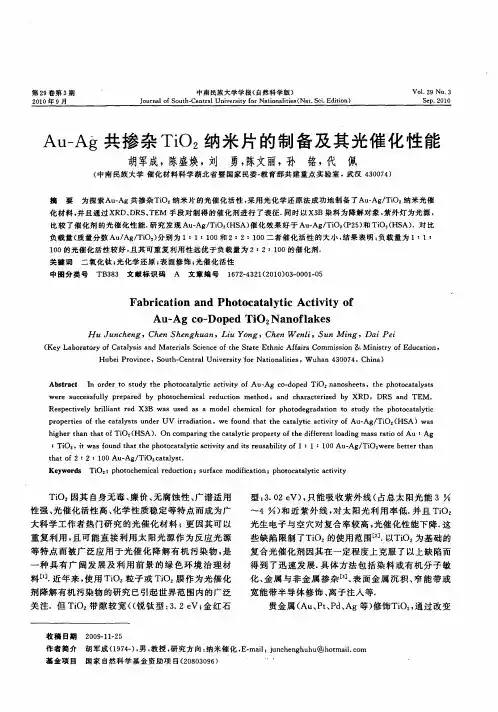
Vo . 9No 3 12 .
S p 01 e .2 0
AuA窘共 掺 杂 Ti 纳米 片 的 制 备 及 其 光 催 化 性 能 — O2
胡军成, 陈盛焕 , 勇, 刘 陈文丽, 孙 铭, 代 佩
( 南 民族 大 学 催 化 材 料 科 学 湖 北 省 暨 国 家 民 委一 育 部 共 建 重 点 实 验 室 , 汉 4 0 7 ) 中 教 武 3 04
h g e h n t a f O2 HSA) i h rt a h to Ti ( .On c mp rn h a a y i r p ry o h i e e t o d n s a i fAu : o a i g t e c t l tcp o e t f ed f r n a i g ma sr to o t f l Ag
比 较 了催 化 剂 的光 催 化 性 能 . 究 发 现 AuAg TO2H A) 化 效 果 好 于 AuAg Ti ( 2 ) Ti ( A) 研 — /i (S 催 — / OzP 5 和 O。HS .对 比
负 载 量 ( 量 分 数 Au Ag Ti 分 别 为 1: 1 0和 2: 1 0二 者 催 化 活性 的 大 小 , 果 表 明 : 载量 为 1:1: 质 / / O) 1: 0 2: 0 结 负 1 0的光 催 化 活 性 较 好 , 其 可 重 复 利 用 性 远 优 于负 载量 为 2: 1 0的 催 化 剂 . 0 且 2: 0 关键词 二 氧 化 钛 ; 化 学 还 原 ; 面 修 饰 ; 催化 活性 光 表 光
: O , t sfu d t a ep o o aay i a t i n sru a it f Ti 2 i wa o n t h h t c tlt ci t a di e s bl yo h t c vy t i I:1: 0 u Ag T O2 e eb t r h n 1 0A - / i w r et a e t t a f 2: 0 - / i tl s. ht o 2: 1 0Au Ag T O2 aay t c
Au-CuO/TiO2催化剂用于CO2中微量H2的脱除
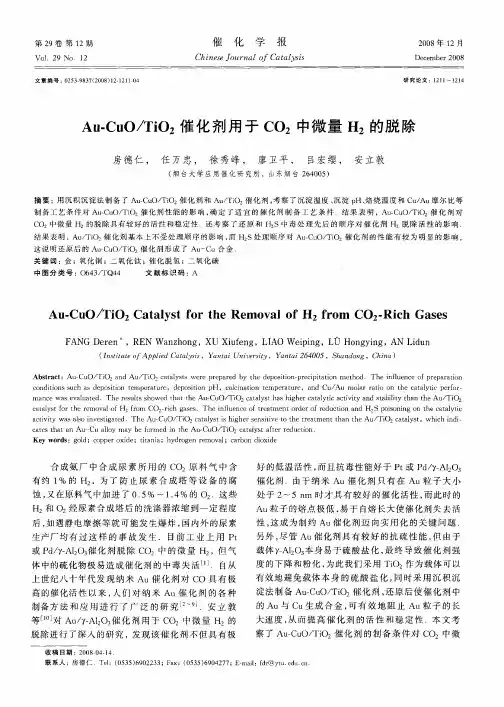
第2 9卷 第 1 2期
Vo .2 .1 1 9 No 2
催
化
学 报
20 0 8年 1 2月
De e e 0 8 c mb r2 0
C ie o ra fC tls hns J u n l aayi e o s
文 章 编 号 :0 5 — 8 7 2 0 ) 2 1 1 —4 2 39 3 (0 8 1—2 10
( ntt t o I siue /Ap l d Caayi ,Ya t iUn vri p i tlss e n a iest y,Ya ti 6 0 5,S a d n n a 4 0 2 h n o g,C ia) hn
Ab ta t sr c :Au C O/ O2a d Au Ti a ay t we e p e a e y t e d p st n p e ii t n me h d — u Ti n / O2c t ls s r r p r d b h e o i o — r cpt i t o .Th n l e c fp e a ai n i ao e i f n e o r p r t u o c n i o ss c s d p st n t mp r t r ,d p s i n p ,c li a in t mp r t r ,a d C / lr r t n t e c tl t e fr o dt n uh a e o io e eau e e oio H i i t a c t e e a u e n u Au moa a i o h a ay i p r — n o o c o
tio2折射率

tio2折射率
【实用版】
目录
1.TIO2 的基本介绍
2.TIO2 的折射率特性
3.TIO2 折射率的应用领域
4.TIO2 折射率的测量方法
5.TIO2 的未来发展前景
正文
【1.TIO2 的基本介绍】
TIO2,全称为二氧化钛,是一种常见的无机非晶态材料。
它具有良好的光学性能、化学稳定性和热稳定性,广泛应用于涂料、塑料、橡胶、印刷油墨等领域。
【2.TIO2 的折射率特性】
TIO2 的折射率较高,通常在 1.8-2.5 之间,且随着波长的变化而变化。
这种特性使得 TIO2 在光学领域有着广泛的应用,如光纤通信、光学薄膜等。
【3.TIO2 折射率的应用领域】
TIO2 的高折射率特性使其在光纤通信领域有着广泛的应用。
由于TIO2 的折射率较高,可以减少光信号在光纤中的传输损失,提高光信号的传输效率。
此外,TIO2 还被广泛应用于制备光学薄膜,如防反射膜、增透膜等。
【4.TIO2 折射率的测量方法】
TIO2 折射率的测量方法有多种,如光栅法、干涉法、光纤法等。
这
些方法各有优缺点,需要根据实际应用需求选择合适的测量方法。
【5.TIO2 的未来发展前景】
随着科技的进步和需求的增长,TIO2 在未来的发展前景广阔。
在光纤通信领域,随着 5G 技术的推广,对高速、大容量的光纤通信需求将持续增长,TIO2 的需求也将随之增长。
在光学薄膜领域,随着电子产品的轻薄化、便携化,对光学薄膜的需求也将持续增长。
TiO2晶型对Au/TiO2上光催化分解臭氧的影响
文 章 编 号 :0 5 — 8 7 2 0 1 0 5 5 2 3 9 3 ( 0 7) 1 9 80
研 究论 文 : 5 9 8~9 2 6
TO2 i 晶型 对 A / i 上 光 催 化分 解 臭氧 的 影 响 u TO2
董 芳 , 杨 冬 梅 , 张 敏 , 杨 建 军
维普资讯
第 2 卷 第 1 期 8 1
V0 .28 1 No. 1 l
催 化 学 报
C i ee o a f C t ls h n s u n l aa yi J r o s
20 0 7年 1 1月
No e e 0 7 v mb r2 0
( 南 大 学特 种 功 能 材 料 重 点 实验 室 ,河 南 开 封 4 5 0 ) 河 7 0 1
摘 要 :以不 同晶 型 TO 为 载 体 , 用沉 积一 淀 法 制 备 了 A / O 光 催 化 剂 , 用 紫 外 一 见 漫 反 射 光谱 、 射 线 光 电子 能 谱 i2 采 沉 uTi2 并 可 x
o s o sOz n v rAu T o2 fGa e u o e o e / i
D NG F n , A G D n m i H N n A G Ja jn O a g Y N o g e ,Z A G Mi ,Y N i u n
( e a oaoy rS ei u ci a Mae i s e a nv ri K yL b r t p c l n t n l t a ,H n n U i s y,K i n 7 0 1 e a ,C ia r F a o rl e t a eg 4 5 0 ,H n n h n ) f
f s elca c p crso y u erf tn es eto c p ,X—a h tee to p cr so y ( S) n u fc h tv l g p crso y e ry p oo lcr n s e to c p XP ,a d s r e p oo ot es eto c p a a
TiO2光催化原理和应用
TiO2光催化原理和应用WORD格式整理一.前言在世界人口持续增加以及广泛工业化的过程中,饮用水源的污染问题日趋严重。
根据世界卫生组织的估计,地球上22%的居民日常生活中的饮用水不符合世界卫生组织建议的饮用水标准。
长期摄入不干净饮用水将会对人的身体健康造成严重危害,世界范围内每年大概有200万人由于水传播疾病死亡。
水中的污染物呈现出多样化的趋势,常见的污染物包括有毒重金属、自然毒素、药物、有机污染物等。
常规的饮用水净化技术有氯气、臭氧和紫外线消毒以及过滤、吸附、静置等,但是这些方法对新生的污物往往不是非常有效,并且可能导致二次污染。
包括我国在内世界范围内广泛应用的氯气消毒法,可能在水中生成对人类健康有害的高氯酸盐。
臭氧消毒是比较安全的消毒方法,但是所需设备昂贵;而紫外线消毒法需要能源支持,并且日常的维护都需要专业的技术人员;吸附法一般需要消耗大量的吸附剂,使用过的吸附剂一般需要额外的处理。
这些缺点限制了它们的应用范围,迫切需要发展一种高效、绿色、简单的净化水技术。
自然界中,植物、藻类和某些细菌能在太阳光的照射下,利用光合色素将二氧化碳(或硫化氧)和水转化为有机物,并释放出氧气(或氢气)。
这种光合作用是一系列复杂代谢反应的总和,是生物界赖以生存的基础,也是地球碳氧循环的重要媒介。
光化学反应的过程与植物的光合作用很相似。
光化学反应一般可以分为直接光解和间接光解两类。
直接光解为物质吸收能量达到激发态,吸收的能量使反应物的电子在轨道间的转移,当强度够大时,可造成化学键的断裂,产生其它物质。
直接光解是光化学反应中最简单的形式,但这类反应产率一般较低。
间接光解则为反应系统中某一物质吸收光能后,再诱使另一种物质发生化学反应。
半导体在光的照射下,能将光能转化为化学能,促使化合物的合成或使化合物(有机物、无机物)分解的过程称之为半导体光催化。
半导体光催化是光化学反应的一个前沿研究领域,它能使许多通常情况下难以实现或不可能进行的反应在比较温和的条件下顺利进行。
tio2 化学意思
tio2 化学意思
TiO2是二氧化钛的化学式,也称为钛白粉。
它是一种重要的无
机化合物,由钛和氧元素组成。
在化学意义上,TiO2是一种白色固体,常见的结构有金红石型和锐钛矿型等。
它具有许多重要的应用,包括作为颜料(用于油漆、涂料、塑料等)、光催化剂(用于环境
净化和能源生产)、紫外线吸收剂(用于防晒霜和防晒液)等。
此外,TiO2还被用作工业催化剂、电子材料和陶瓷材料的添加剂等。
总的来说,TiO2在化学上扮演着重要的角色,其广泛的应用使得它
成为了一种非常重要的化学物质。
TiO2综述
TiO2综述纳⽶TiO2的性能、应⽤及其制备⽅法综述摘要:纳⽶TiO2具有独特的光催化性、优异的颜⾊效应以及紫外线屏蔽等功能, 在光催化剂、化妆品、抗紫外线吸收剂、功能陶瓷、⽓敏传感器件等⽅⾯具有⼴阔的应⽤前景。
国内外⽂献对纳⽶TiO2的性质、应⽤及其制备⽅法进⾏了⼤量的性能、应⽤及制备⽅法研究进⾏了综述。
的研究报道, 本⽂对有关纳⽶TiO2关键字:纳⽶TiO2、性能、应⽤、制备⼀、简介:纳⽶⼆氧化钛,亦称纳⽶钛⽩粉。
从尺⼨⼤⼩来说,通常产⽣物理化学性质显著变化的细⼩微粒的尺⼨在100纳⽶以下,其外观为⽩⾊疏松粉末。
具有抗紫外线、抗菌、⾃洁净、抗⽼化功效,可⽤于化妆品、功能纤维、塑料、油墨、涂料、油漆、精细陶瓷等领域。
⼆、分类:①、按照晶型可分为:⾦红⽯型纳⽶钛⽩粉和锐钛型纳⽶钛⽩粉。
②、按照其表⾯特性可分为:亲⽔性纳⽶钛⽩粉和亲油性纳⽶钛⽩粉。
③、按照外观来分:有粉体和液体之分,粉体⼀般都是⽩⾊,液体有⽩⾊和半透明状。
三、纳⽶TiO2的性能:纳⽶TiO2除了具有与普通纳⽶材料⼀样的表⾯效应、⼩尺⼨效应、量⼦尺⼨效应和宏观量⼦隧道效应等外, 还具有其特殊的性质, 尤其是催化性能。
3. 1 基本物化特性纳⽶TiO2有⾦红⽯、锐钛矿和板钛矿3种晶型。
⾦红⽯和锐钛矿属四⽅晶系, 板钛矿属正交晶系,⼀般情况下,板钛矿在650℃转变为锐钛矿,锐钛矿915℃转变为⾦红⽯,结构转变温度与TiO2颗粒⼤⼩、含杂质及其制备⽅法有关,颗粒愈⼩,转变温度愈低,锐钛型纳⽶TiO2向⾦红⽯型转变的温度为600℃或低于此温度,纳⽶TiO2化学性能稳定,常温下⼏乎不与其它化合物反应,不溶于⽔、稀酸,微溶于碱和热硝酸,不与空⽓中CO2、SO2、O2等反应,具有⽣物惰性和热稳定性,⽆毒性[1]。
3. 2光催化性纳⽶TiO2是⼀种n型半导体材料,禁带宽度较宽,其中锐钛型为3.2eV,⾦红⽯型为3.0eV,当它吸收了波长⼩于或等于387.5nm 的光⼦后,价带中的电⼦就会被激发到导带,形成带负电的⾼活性电⼦e-,同时在价带上产⽣带正电的空⽳h+,吸附在TiO2表⾯的氧俘获电⼦形成?O2-,⽽空⽳则将吸附在TiO2表⾯的OH-和H2O氧化成具有强氧化性的?OH,反应⽣成的原⼦氧、氢氧⾃由基都有很强的化学活性, 氧化降解⼤多数有机污染物,同时空⽳本⾝也可夺取吸附在半导体表⾯的有机物质中的电⼦,使原本不吸收光的物质被直接氧化分解,这两种氧化⽅式可能单独起作⽤也可能同时起作⽤,对于不同的物质两种氧化⽅式参与作⽤的程度有所不同[2]。
- 1、下载文档前请自行甄别文档内容的完整性,平台不提供额外的编辑、内容补充、找答案等附加服务。
- 2、"仅部分预览"的文档,不可在线预览部分如存在完整性等问题,可反馈申请退款(可完整预览的文档不适用该条件!)。
- 3、如文档侵犯您的权益,请联系客服反馈,我们会尽快为您处理(人工客服工作时间:9:00-18:30)。
Photocatalysis of Au 25-modi fied TiO 2under visible and near infrared lightAtsushi Kogo a ,Nobuyuki Sakai a ,Tetsu Tatsuma a ,b ,⁎a Institute of Industrial Science,The University of Tokyo,4-6-1Komaba,Meguro-ku,Tokyo 153-8505,Japan bPRESTO,Japan Science and Technology Agency (JST),4-1-8Honcho,Kawaguchi,Saitama 332-0012,Japana b s t r a c ta r t i c l e i n f o Article history:Received 28April 2010Received in revised form 13May 2010Accepted 17May 2010Available online 24May 2010Keywords:Gold cluster PhotocatalystVisible and near infrared light TiO 2Visible light-driven photocatalysis of Au 25-modi fied TiO 2was investigated.It induces oxidation of phenol derivates and ferrocyanide and reduction of Ag +,Cu 2+and dissolved oxygen.Thermodynamically uphill reactions such as oxidation of phenol accompanied by reduction of Cu 2+are also driven.The photocatalysis,which is based on the excitation of Au 25,is observed even under 860nm light.©2010Published by Elsevier B.V.1.IntroductionGold clusters,which are smaller than 2nm in diameter,have discrete electronic levels due to quantum size effects [1,2],whereas gold nanoparticles larger than 3nm and bulk gold have electronic band structure.Among the clusters,Au 25,which is thermodynami-cally the most stable,have been extensively studied and clari fied to have unique properties such as an optical absorption in visible and near infrared (NIR)region [1,3],paramagnetism [4],fluorescence [5]and two-photon absorption [6].Recently,we have found that the Au 25-modi fied TiO 2electrodes exhibit anodic photocurrents and negative photopotential shifts in response to visible and NIR light in the presence of appropriate electron donors [7].TiO 2modi fied with other Au n (n =15–39)clusters also gives photoresponses and each photocurrent action spectrum is consistent with the corresponding optical absorption spectrum.Of the clusters examined,Au 25shows the highest ef ficiency.Visible and NIR light excites electrons of the gold clusters from HOMO to LUMO level.The holes generated in HOMO receive electrons from donors,and the excited electrons in LUMO are injected into the TiO 2conduction band and eventually accepted by the oxidized donors at the counter electrode.The cluster-modi fied TiO 2is therefore expected to work as a photocatalyst for oxidation of donors and reduction of acceptors.TiO 2is the most widely used photocatalyst,which is applied to self-cleaning and self-sterilizing materials and removal of hazardous compounds [8].However,TiO 2works only under ultraviolet light.Recently,many approaches such as N-doping [9],dye-sensitization[10]and metal ion adsorption [11]are explored to utilize visible and NIR light for photocatalysis.In this study,we examined the photocatalysis of the Au 25-modi fied TiO 2under visible and NIR light.Although thermal catalysis of gold nanoparticles or clusters adsorbed on metal oxides [12]and photocatalysis sensitized by localized surface plasmon resonance of gold nanoparticles [13,14]have been studied,there are no reports on photocatalysis of TiO 2modi fied with gold clusters,which exhibits no plasmon resonance.In this study,we used Au 25,which gives the highest photovoltaic property among the gold clusters and studied the photocatalysis of the Au 25-modi fied TiO 2.2.Experimental 2.1.Sample preparationAnatase TiO 2films (600nm thick)were prepared by spin-coating (1500rpm,10s)on ITO-coated or Pyrex glass substrates from a TiO 2slurry (STS-21,Ishihara Sangyo)diluted to 50%with pure water,followed by annealing at 450°C for 1h.Glutathione-protected Au 25clusters (denoted as Au 25)were synthesized according to literatures [3,15].After the removal of excess glutathione by dialysis,Au 25solution was cast on the TiO 2films and left for 2h followed by washing with water and dried.The adsorbed densities on ITO and Pyrex were estimated to be 6.0±0.68and 5.7±0.48nm −2,respectively.2.2.Photocurrent measurementsPhotocurrents of a Au 25–TiO 2electrode were measured in a cell shown in Fig.1a (inset).The Au 25–TiO 2working electrode and an ITOElectrochemistry Communications 12(2010)996–999⁎Corresponding author.Institute of Industrial Science,The University of Tokyo,4-6-1Komaba,Meguro-ku,Tokyo 153-8505,Japan.E-mail address:tatsuma@iis.u-tokyo.ac.jp (T.Tatsuma).1388-2481/$–see front matter ©2010Published by Elsevier B.V.doi:10.1016/j.elecom.2010.05.021Contents lists available at ScienceDirectElectrochemistry Communicationsj o u r n a l h o m e p a g e :w ww.e l s ev i e r.c o m /l o c a t e /e l e c o mcounter electrode were soaked in 0.1M sodium acetate buffer containing 0.1M LiNO 3and a donor (pH 4.94±0.027,deaerated by N 2)and 0.1M aqueous LiNO 3containing an acceptor,respectively.The solutions were bridged with a KNO 3salt bridge.The working electrode was irradiated with 500–750nm light (10mW cm −2)using a xenon lamp (LA-251Xe,Hayashi Tokei)through a sharp-cut filter (SCF-25C-52Y,Sigma Koki),and short-circuit photocurrents were measured with an ammeter (1280C,Solartron).2.3.Spectroscopic measurementsThe Au 25–TiO 2film-coated glass substrate was soaked in acetoni-trile containing a donor and an acceptor,and absorbance changes of the film were measured in situ with a spectrophotometer (HR4000CG-UV-NIR,Ocean Photonics)under 500–750nm light (10mW cm −2).A sharp-cut filter (SCF-25C-48Y,Sigma Koki)was employed to prevent excitation of TiO 2by the probe light.A monochromatic light (6×1015photons cm −2s −1)was irradiated by using a xenon lamp (LAX-102,Asahi Spectra)with a band-pass filter (FWHM 10nm,Asahi Spectra)to record the action spectrum for the photocatalysis.3.Results and discussion 3.1.Photocatalytic oxidationThe Au 25–TiO 2electrode was irradiated with 500–750nm light in the two-compartment cell.The working and counter electrode compartments contain a donor (1mM)and Ag +as an acceptor (0.1M),respectively.Observed anodic short-circuit photocurrent densities after a 1-h irradiation are plotted against standard electrode potential E °of the donors in Fig.1a.In the presence of hydroquinone as a donor,the Au 25–TiO 2electrode exhibited a much higher photocurrent density (11.5μA cm −2)than a TiO 2electrode without clusters (0.18μA cm −2)or the Au 25–TiO 2electrode without donors (0.16μA cm −2).The photocurrent,which reverts to zero immediately after turning the light off,is therefore generated as a result of the electron transfer from the photoexcited Au 25to TiO 2and that from hydroquinone to Au 25.The electrons transferred to TiO 2are eventually accepted by Ag +,via the external circuit and the counter electrode.In the presence of a phenol derivative (hydroquinone,catechol,phenol or p -cresol)or ferrocyanide as a donor,the anodic photocurrent was larger than that in a control experiment without donors.In the presence of methanol,ethanol,formaldehyde or formic acid,however,the photocurrent was as low as that in the absence of donors.In the control experiment,in which a small current was observed,water may work as a donor.In a practical system,photocatalytic oxidation and reduction proceed on the same film (Fig.1b,inset).We therefore immersed the Au 25-modi fied TiO 2film on a glass substrate in acetonitrile containing AgNO 3(0.1M)and an electron donor (0.1M),and irradiated it with 500–750nm light.The absorbance of the film was monitored in situ at 500nm.In the presence of hydroquinone as a donor,the absorbance increased under irradiation as shown in Fig.2(inset).The increase is ascribable to the plasmon resonance of the silver nanoparticles deposited by the photocatalytic reduction of Ag +.Absorbance increases during the initial 3-min irradiation are plotted in Fig.1b as indices for the oxidation rates of donors.In the presence of hydroquinone,catechol,bisphenol A,p -cresol,phenol or formic acid as a donor,the increase rate of absorbance was signi ficantly larger than that in a control experiment without donors.On the other hand,in the presence of methanol,ethanol or formaldehyde,the increase rate was as low as that in the absence of donors.Again,in thecontrolFig.1.Photocatalytic oxidation ability of the Au 25-modi fied TiO 2under visible light irradiation (500–750nm,10mW cm −2)accompanied by reduction of Ag +:(a)short-circuit photocurrent densities measured in the two-compartment cell (inset)and (b)absorbance increase rates plotted against E °of the donors.The E °values (pH 5)of methanol,ethanol,formaldehyde and formic acid are calculated from the standard Gibbs energy of formation and those of the other donors are obtained from literatures [16–19].Fig.2.Action spectrum for the photocatalytic reduction of 0.1M Ag +accompanied by oxidation of 0.1M hydroquinone by the Au 25-modi fied TiO 2(6×1015photons cm −2s −1)(circles)and absorbance spectrum of 5.0×10−6M Au 25aqueous solution (curve).Inset shows the absorbance change during 500–750nm light irradiation (180–360s,10mW cm −2).997A.Kogo et al./Electrochemistry Communications 12(2010)996–999experiment,water dissolved in acetonitrile may play the role of a donor.Irradiation of Au 25with 500–750nm light should excite electrons from HOMO to LUMO,LUMO+1and LUMO+2[1,2].Since the potential of HOMO is +1.52V vs.NHE (pH 5),donors that have more negative E °could be oxidized in the photocatalysis.Although all the donors examined fall into this category,methanol,ethanol,formal-dehyde,formic acid and water are poorly oxidized.In the present system,species that generally show fast outer-sphere electrochemical reactions seem to be good donors.Inner-sphere electrochemical reactions,which are frequently seen on bare metal surfaces,are not expected for the clusters densely protected by glutathione.3.2.Photocatalytic reductionOpen-circuit potential of the Au 25–TiO 2electrode measured in a three-electrode system shifted from +0.40to +0.15V vs.NHE by 500–750nm light irradiation (10mW cm −2)in 0.1M aqueous LiNO 3without donors and acceptors.It is suggested from the thermody-namic viewpoint that acceptors whose E °is more positive than the observed photopotential should be reduced by the Au 25–TiO 2photocatalysis.The potential is more positive than the lower edge of conduction band of TiO 2(−0.5V at pH 5),probably because the rate of back electron transfer from TiO 2conduction band to Au 25HOMO level is not negligible in comparison with the rate of electron injection from Au 25LUMO to TiO 2conduction band in the absence of donors.We measured the photocurrents generated under visible light using the two-compartment cell.The working and counter electrode compartments contain hydroquinone as a donor (0.1M)and an acceptor (1mM,or 1.3mM for oxygen [20]),respectively.Ag +and Cu 2+(Fig.3)as well as oxygen (3.7μA cm −2)as acceptors gave much higher photocurrents than that observed in a control experiment without acceptors (0.06μA cm −2).In contrast,the photocurrents in the presence of Pb 2+or Ni 2+were as small as that in the control experiment.These results were consistent with the experimentally evaluated photopotential shown above.The absorbance of the Au 25–TiO 2film on a glass substrate was measured in situ during visible light irradiation in acetonitrile contain-ing hydroquinone (0.1M)and an acceptor (0.1M).When Ag +is employed as an acceptor,the absorbance signi ficantly increased (63×10−5s −1),suggesting that Ag +is reduced to silver nanoparticles.In contrast,the absorbance scarcely changed in the presence of the other metal ions examined (i.e.Cu 2+and Ni 2+).Although the photocurrentwas observed in the presence of Cu 2+,the absorbance did not increase possibly due to oxidative dissolution of the deposited copper by dissolved oxygen.3.3.Uphill reactionsSome of the reactions examined are thermodynamically uphill ones.For instance,whereas phenol (E °=+0.87V vs.NHE at pH 5)cannot reduce Ag +(E °=+0.80V)spontaneously,the reaction is driven by the Au 25–TiO 2photocatalyst.One of the advantages of photocatalyses over conventional catalyses is driving such uphill reactions,resulting in conversion of light energy to chemical one.Here we examined an even steeper uphill reaction,phenol oxidation coupled with Cu 2+reduction (E °=+0.34V).In the cell that contains 1mM phenol and 1mM Cu(NO 3)2in the working and counter electrode compartments,respectively,0.38μA cm −2of photocurrent was observed under 500–750nm light.The current was much larger than that in the absence of any donors and acceptors (0.03μA cm −2).The Au 25–TiO 2can therefore photocatalytically lift electrons by +0.53V by the aid of visible light energy.3.4.Action spectrum for the photocatalysisIn order to clarify the active wavelength range of the photo-catalysis and to con firm that Au 25is essential for the photocatalysis,an action spectrum was measured for photocatalytic reduction of Ag +with oxidation of hydroquinone,on the basis of the absorbance increase of the Au 25–TiO 2film under monochromatic light due to deposition of silver nanoparticles.As shown in Fig.2,the action spectrum for the absorbance increase rate showed good agreement with the optical absorption spectrum of a Au 25aqueous solution.This result strongly indicates that the observed photocatalysis is based on the excitation of Au 25and that the internal quantum ef ficiency is virtually constant over the range examined.The photocatalysis can be driven even at 860nm.4.ConclusionsThe Au 25-modi fied TiO 2has been proved to work as a photo-catalyst under visible and NIR light (≤860nm),which drives oxidation of phenol derivatives and ferrocyanide and reduction of Ag +,Cu 2+and oxygen.The photocatalysis is based on electron transfer from photoexcited Au 25to TiO 2and that from an electron donor to the Au 25.Uphill reactions (e.g.ΔE °=0.53V)can also be driven photocatalytically.AcknowledgmentsThis work was financially supported in part by KAKENHI (No.19049008for TT)on Priority Area “Strong Photon-Molecule Coupling Fields (No.470)”and KAKENHI (No.22710100for NS)from MEXT of Japan.References[1]M.Zhu,C.M.Aikens,F.J.Hollander,G.C.Schatz,R.Jin,J.Am.Chem.Soc.130(2008)5883.[2] C.M.Aikens,J.Phys.Chem.C 112(2008)19797.[3]Y.Negishi,K.Nobusada,T.Tsukuda,J.Am.Chem.Soc.127(2005)5261.[4]M.Zhu,C.M.Aikens,M.P.Hendrich,R.Gupta,H.Qian,G.C.Schatz,R.Jin,J.Am.Chem.Soc.131(2009)2490.[5]T.Huang,R.W.Murray,J.Phys.Chem.B 105(2001)12498.[6]G.Ramakrishna,O.Varnavski,J.Kim,D.Lee,T.Goodson,J.Am.Chem.Soc.130(2008)5032.[7]N.Sakai,T.Tatsuma,Adv.Mater.,in press.doi:10.1002/adma.200904317.[8]M.R.Hoffmann,S.T.Martin,W.Choi,D.W.Bahnemann,Chem.Rev.95(1995)69.[9]R.Asahi,T.Morikawa,T.Ohwaki,K.Aoki,Y.Taga,Science 293(2001)269.[10] E.Borgarello,J.Kiwi,E.Pelizzetti,M.Visca,M.Grätzel,Nature 289(1981)158.[11]H.Irie,S.Miura,K.Kamiya,K.Hashimoto,Chem.Phys.Lett.457(2008)202.Fig.3.Photocatalytic reduction ability of the Au 25-modi fied TiO 2under visible light irradiation (500–750nm,10mW cm −2)accompanied by oxidation of hydroquinone.998 A.Kogo et al./Electrochemistry Communications 12(2010)996–999[12]M.Haruta,Chem.Rec.3(2003)75.[13]Y.Tian,T.Tatsuma,J.Am.Chem.Soc.127(2005)7632.[14] E.Kowalska,R.Abe,B.Ohtani,mun.(2009)241.[15]Y.Shichibu,Y.Negishi,H.Tsunoyama,M.Kanehara,T.Teranishi,T.Tsukuda,Small3(2007)835.[16]J.C.Suatoni,R.E.Snyder,R.O.Clark,Anal.Chem.33(1961)1894.[17]W.C.Barrette Jr.,H.W.Johnson Jr.,D.T.Sawyer,Anal.Chem.56(1984)1890.[18]P.J.Elving,A.F.Krivis,Anal.Chem.30(1958)1645.[19]H.Kuramitz,Y.Nakata,M.Kawasaki,S.Tanaka,Chemosphere45(2001)37.[20]R.Battino,H.L.Clever,Chem.Rev.66(1966)395.999A.Kogo et al./Electrochemistry Communications12(2010)996–999。
